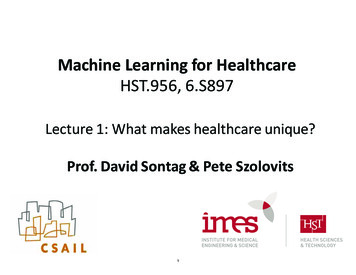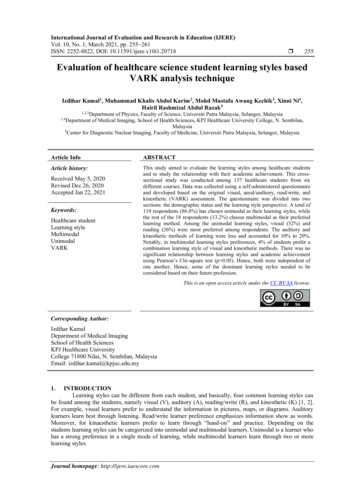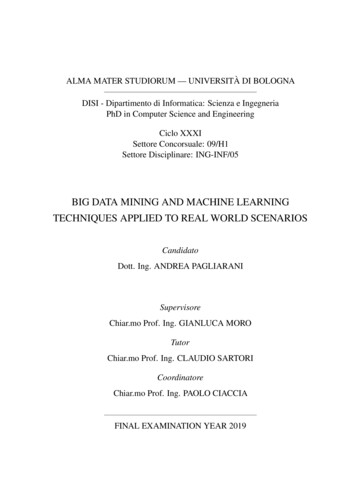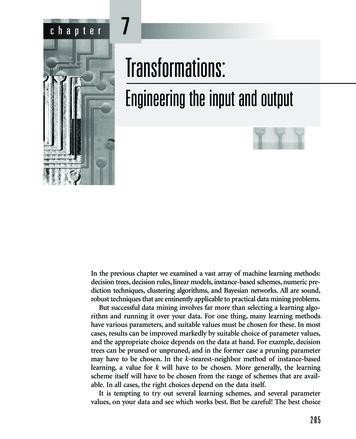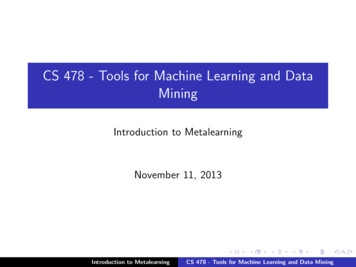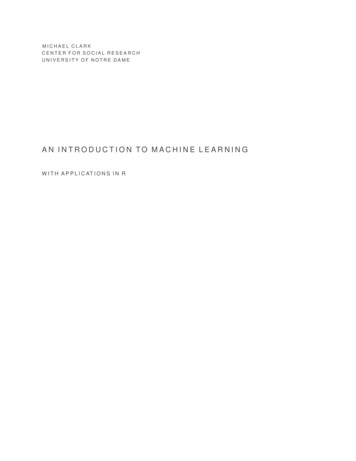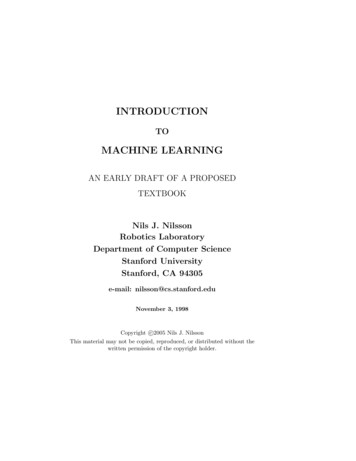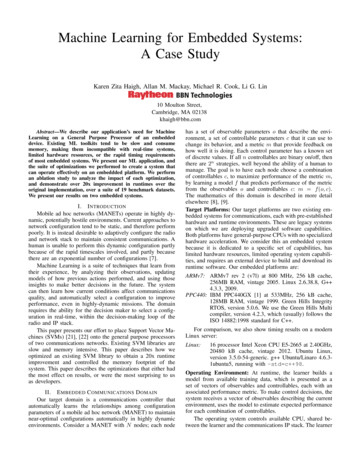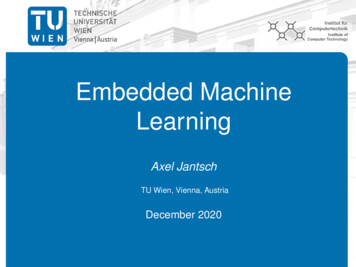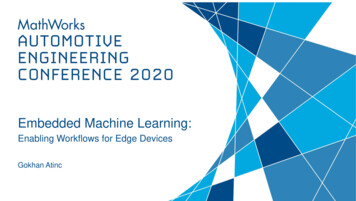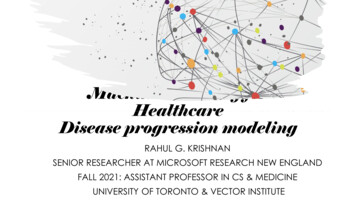
Transcription
Machine Learning forHealthcareDisease progression modelingRAHUL G. KRISHNANSENIOR RESEARCHER AT MICROSOFT RESEARCH NEW ENGLANDFALL 2021: ASSISTANT PROFESSOR IN CS & MEDICINEUNIVERSITY OF TORONTO & VECTOR INSTITUTE
Overview Introduction ML in healthcare - from data to insights Disease progression MotivationProblem statementDeep Markov ModelsNeural Intervention Effect FunctionsNeural Pharmacodynamic State Space ModelsResultsFuture work Conclusion Opportunities in research
Digitization of electronic healthcaredataPercentageof hospitalsin the US withEMRs[Henry et al., ONC Data Brief, May 2016]
Understand diseasebiologyClinical dataBuild clinical tools
Disease registries
Disease progressionNeural Pharmacodynamic State SpaceModels,Hussain & Krishnan, Sontag, ICML 2021
Modeling disease progression What can we learn about diseases using data of patients who suffer from it? Goal: Unsupervised learning of clinical biomarkers:
Technicalchallenges inhealthcare data High-dimensional longitudinal dataX has nonlinear variation Missingness in X Left and right censorship Complex variation in X due totreatment protocols U Rare diseases: Small number ofsamples to learn from
Statistical modelsof sequential dataRecurrent Neural Network (RNN)(Gaussian) state space models (SSM)
Deep Markov Models [DMM]Transitionfxn. Parameter estimation via maximumlikelihood Use variational inference with aninference network for approximatingthe intractable posterior distributionEmissionfxn.NeuralnetworksStructured inference networks for nonlinear state space models, Krishnan, Shalit & Sontag, AAAI 2017
How does the DMM work?Latent state as a proxy forpatient stateTreatmentsClinicalObservations
A middle ground for models ofsequential data RNNs/DMMs SSMs Powerful black-box modelsfor sequences Susceptible to overfittingwhen data is scarce Latent variable model withhistory of use in diseaseprogression Linearity can be a limitationUse domainknowledge to designdeep generativemodels for clinical
Domain knowledge for diseaseprogression What is the right domain knowledge to use for cancerprogression? Lines of therapy Mechanism of drug-effect How do we use this knowledge? Design a new neural architecture for the transition function
From lines of therapy to local and globalclocksCapture timefrom start oftherapyCapture timerelative toprogression eventGlobal clockLocal clock
Approximating the mechanistic effect ofdrugs
Pharmacokinetics andPharmacodynamics Pharmacokinetics How drugs move within the body. Pharmacodynamics Study of how the body responds to the drugs being prescribed Traditional PK-PD models are designed to model dynamicsof a single biomarker due to a single drug Our work: proposes new neural architectures to model theeffect of multiple simultaneous interventions on latentrepresentations
Neural intervention effect functions Modeling baseline conditional variation Modeling slow gradual relapse after treatment Log-cell killInspired by: Captures rapid variation in representations due to treatmentInspired by:
Neural architecture for thetransition functionTransitionfxn.SSM-PKPD
Cohort characteristics 1143 patients aligned by the start of treatment for multiplemyeloma Treated according to current standard of care Worked with an oncologist to select: X: 16 clinical biomarkers over time U: 9 indicators of treatments (such as drugs and line of therapy) B: 16 baseline features PCA projections of RNA SNP data Demographics
Baselines
Generalization against baselinesSemisyntheticdataMultipleMyelomadata
Where do the gains come from?
What utility do the clocks have?
Introspection into the learned latentspace
Predicting clinical biomarkers into thefuture(using baseline data)
Predicting clinical biomarkers into thefuture(after observing the patient for 15months)
Conclusion &Opportunities in research
Conclusion - Idea in a slide Goal: Conditional density estimation of non-linear time-varying data Challenge: Data is scarce and missing, Traditional methods overfit or are insufficiently expressive Approach: Key idea: Incorporate domain knowledge in how interventions affect latentrepresentations to improve generalization Pharmacodynamic modeling - Neural Intervention Effect Functions Treatment protocols - local and global clocks PKPD-SSM: Neural pharmacodynamic state space model Consequence: Improvements in model’s ability to generalize and forecast clinical biomarkers
Conclusion – take aways When applying deep generative models to real data,think deeply about and incorporating domain knowledge Incorporating structure of the problem into the model canimprove generalization (especially when data is scarce)
Future Work Validating results in a larger, independent cohort Working with collaborators to study the model on data fromVeteran’s Affairs (VA) Developing clinical decision support tools Understanding the needs of oncologists when treating patientsand what forecasting tasks might be of interest From predictive to counterfactual models Use as a starting point for model-based reinforcement learning
Opportunities in researchMulti-modal decision making inoncologyClinicalnotesImagingLabtestsGenetics Forecasting patient dataPredicting time to progressionLikelihood of successful treatmentDisease sub-typing
Questions?
Key idea: Incorporate domain knowledge in how interventions affect latent representations to improve generalization Pharmacodynamic modeling - Neural Intervention Effect Functions Treatment protocols - local and global clocks PKPD-SSM: Neural pharmacodynamic state space model
